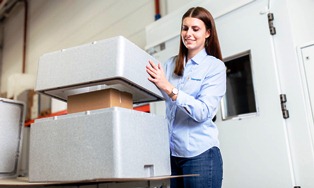DHL and other logistics companies were already transporting pharmaceutical products at minus 70°C in Schaumaplast boxes packed with dry ice before the coronavirus pandemic

As the range of coronavirus vaccines grows, so do the requirements for their distribution. The different vaccines need to be stored and transported at different temperature ranges—often together in the same vehicle or cold store. Handling complex processes like this is routine for leading logistics companies such as DHL. But they depend on the skills of packaging providers and raw materials suppliers like Schaumaplast and BASF.
DHL and other logistics companies were already transporting pharmaceutical products at minus 70°C in Schaumaplast boxes packed with dry ice before the coronavirus pandemic. They also use the passive cooling systems manufactured by Schaumaplast for freezer and fridge temperature ranges for other products. “Many of these methods are not new. The challenge for the coronavirus vaccine logistics in relation to our cooling systems is rather to adapt the known technology as quickly as possible to specific requirements such as pack sizes as well as storage and transport times,” explains Martin Raack, key account manager at Schaumaplast.
Under the trade name Thermocon, the Schaumaplast Group, headquartered in Reilingen in Baden-Württemberg, Germany, develops and produces passive—in other words non-electric—cooling systems for the pharmaceutical industry. The lightweight thermal boxes can be fitted with special cooling elements for almost any temperature range and for different volumes. This flexibility in terms of size and cooling range comes into play with the coronavirus vaccine logistics, as three very different temperature ranges—minus 70°C, minus 15°C to minus 25°C, and plus 2°C to plus 8°C—need to be ensured.
“However, a higher temperature does not mean less effort,” says Schaumaplast Managing Director Markus Hoffmann, clearing up a common misconception.
“The minus 15°C to minus 25°C range may place higher demands on the packaging than minus 70°C.” Dry ice, with its temperature of minus 78°C, cannot be used in this situation, where special cooling elements are required instead.
“These need to be cold but not too cold, so the temperature doesn’t fall below minus 25°C but enough cooling energy still ends up in the box,” explains Markus Hoffmann, describing the sophisticated process that needs to run smoothly from the vaccine manufacturer via the packaging producer and logistics company all the way to the user of the individual vaccine doses.
“The employees in the packaging and transport departments have a major responsibility in this respect. They need to be familiar with the thermal packaging and be well trained. Even the best cooling system will fail if the packing procedure is not followed meticulously.”
Before being put to use, the Schaumaplast cooling systems have already successfully undergone a demanding qualification process. They have been exposed to changing ambient temperatures in the company’s own climate chambers. This ensures that the defined temperature limits are reliably maintained.
Subscribe to our newsletter & stay updated.